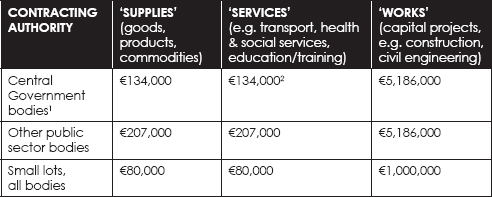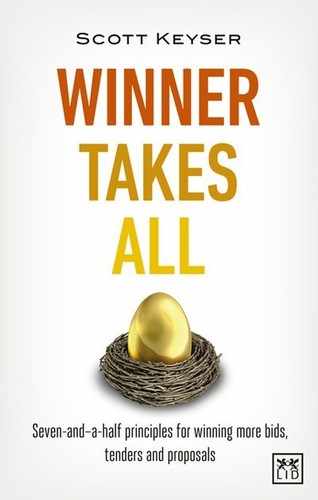GLOSSARY OF TENDERING TERMS
Note: italicized words in the body of a definition mean that the glossary also includes those words.
Beauty parade: formal, face-to-face presentation by shortlisted suppliers to a client panel, usually after submission of the bid document. This is the supplier’s last opportunity to influence the client’s decision. Often referred to as a ‘pitch’ in media and advertising, and an ‘interview’ in professional services.
Best practice: considered the best way to perform a task or activity. ‘Proposals best practice’ refers to a range of behaviours, knowledge and skills that represent the most effective way of winning business proposals.
Bid: a formal written offer or quote made by a supplier/bidder to deliver the contract specified by the buyer in the tender documentation. The bid document typically includes the bidder’s understanding of the client’s situation/needs/goals, the bidder’s proposed solution/value proposition (including price), bidder credentials/customer references, and next steps.
Bidder: a supplier that bids for a contract in response to an ITT or RFP. Interchangeable with Tenderer.
Business development (BD): an organizational function responsible for growing the business, both through cross-selling to existing clients and selling to new ones. In most organizations, this function includes submitting proposals and responding to ITTs/RFPs, or supporting practice groups/business units to do so. In other organizations, ‘BD’ also includes activities more commonly associated with marketing, e.g. PR, events, sponsorship and advertising.
Business Process Outsourcing (BPO): an outsourcing relationship where a third-party provider (a Managed Service Provider, or MSP) takes over and runs a client’s business processes. For example, a company may outsource its HR or recruitment function. In the latter example, a third party assumes the role of the client’s recruiting department by owning and being accountable for its recruitment processes.
Business Questionnaire: what some local/municipal authorities (e.g. Lambeth in south London) call a PQQ (Pre-Qualification Questionnaire), i.e. the first step in the two-step ‘restricted’ public sector procurement procedure.
Buyer: an organization that specifies a purchasing need and puts a tender out to market, to receive bids from interested bidders/suppliers. Also referred to as the ‘client’.
Contracting authority: the formal term for the buyer or buying organization in UK public sector tenders.
CPV codes: Common Procurement Vocabulary codes are a standardized system of classifying public sector contract opportunities in the Official Journal of the European Union (OJEU) by defining the subject of each contract. CPV codes allow potential suppliers to trawl easily through the many thousands of opportunities to find the most relevant ones to their business.
EOI: Expression of Interest. Often the first step in the tendering process, suppliers express their interest in tendering for a contract. Public sector contracting organizations (i.e. the buyer) may ask suppliers for outline information about their company at this stage.
e-Tendering: the electronic version of the procurement process, i.e. supplier registration/expression of interest, contract download, submission of bid document, evaluation of tenders, all done online. It may or may not involve an e-auction (also known as ‘reverse auction’).
EU thresholds: financial levels or limits relating to the estimated lifetime value of a public sector contract. Where the value of a contract equals or exceeds the relevant threshold, the contracting authority must advertise the contract in the Official Journal of the European Union (OJEU) and follow the procedures set out in the Public Contracts Regulations.
Contracting authorities can also divide the contract into smaller chunks called ‘lots’, but no more than 20% of the contract can be let this way. The EU reviews the thresholds every two years. The current thresholds (Jan 2014 - Dec 2015) in euros, net of VAT, are: (PTO)

1 Schedule 1 of the Public Contracts Regulations 2006 lists the central government bodies in the UK subject to the World Trade Organization’s (WTO) Government Procurement Agreement (GPA).
2 Except for certain services, like Research & Development, TV, radio and telecoms, which have a threshold of €200,000.
Note that utilities contracts have their own set of thresholds, governed by the Utilities Contracts Regulations 2006.
Framework Agreement: an umbrella agreement between a buyer and a supplier setting out the terms, conditions and prices of future contracts (‘call-offs’). A form of supplier pre-selection or approved supplier list, it saves the buyer issuing a new tender every time they need to procure something. However, it neither commits the buyer to buying nor guarantees the supplier a sale.
Goods: physical products provided by a supplier, e.g. stationery, chairs, construction materials, IT equipment.
Incumbent: the existing provider of a contract to a client. Incumbents are often required to formally re-bid or re-tender for the contract, instead of it automatically renewing at expiry.
Invitation To Tender (ITT): a document issued by the buying organization that invites shortlisted suppliers to tender for a contract. Interested suppliers respond to that invitation by submitting a bid document or tender response, becoming competitive bidders.
KPI: Key Performance Indicator. Important set of measures by which the client will assess your bid (and your performance in fulfilling the contract). In certain entrepreneurial circles, KPI is also known as Key Person of Influence, i.e. the ‘go-to’ person in their industry.
Low-ball: pricing a bid or tender very low – sometimes even at a loss – to win the contract. Also known as ‘buying the contract’.
Mind-map: a non-linear technique for mapping information using words, pictures, shapes and colours. Useful for capturing the output of brainstorming sessions and for planning documents. Developed by Tony (‘lateral thinking’) Buzan.
Most Economically Advantageous Tender (MEAT): a process for assessing public sector bids, where the evaluators take into account factors other than or in addition to price (e.g. quality, technical merit and running costs). Also known as ‘best value’ or ‘value for money’. If MEAT is used, the contract award criteria must be set out either in the OJEU notice or the tender documents, and the weighting of each criterion given, either as an exact number or as a meaningful range (e.g. ‘Price: 30%-40%’).
In the US, the government procurement equivalent of MEAT is LPTA: Lowest Price Technically Acceptable. This is where the buyer will award the contract to the lowest bid that meets their minimum requirements.
Managed Service Provider (MSP): a company that takes on responsibility for managing another organization’s business processes, e.g. HR, recruitment. This is referred to as a Business Process Outsourcing (BPO) model. For instance, a recruitment MSP would manage, track and report on all temporary staffing, select and manage recruitment suppliers, distribute orders and manage billing.
NDA: Non-Disclosure Agreement, signed by a supplier, who promises to keep confidential any commercially sensitive information that the client may share with them in the course of delivering a contract or assignment.
Official Journal of the European Union (OJEU): an online publication that publishes all public sector contract opportunities whose value equals or exceeds certain EU thresholds.
Pitch: a formal, face-to-face presentation to the client of your proposed solution or value proposition. In professional services, this is often referred to as the ‘interview’.
Pre-Qualification Questionnaire (PQQ): the first hurdle in the UK public sector ‘Restricted’ tender procedure used by contracting authorities to shortlist eligible suppliers. PQQs typically seek information on the supplier’s financial standing, track record and ability to deliver the specified contract. Suppliers satisfying those criteria are then invited, through an Invitation To Tender (ITT), to submit a formal tender response.
Procurement: describes an activity or department whereby an organization buys goods, works and services from outside suppliers.
Proposal: also known as a ‘business proposal’. A sales document written by a supplier to a buyer, proactively proposing a product or service. In contrast with a formal competitive tender that is initiated by the buyer, in a proposal scenario the initiative often comes from the supplier. The proposal is usually based on prior contact with or knowledge of that organization; in many cases, the buyer may already be a client of the supplier. A proposal is typically non-competitive: it may lead to a contract without any other suppliers being involved.
Public Contracts Regulations 2006 (amended 2009): legislation governing how public sector contracts above the EU-set thresholds in England, Wales and Northern Ireland are procured. Public sector procurement in Scotland is covered by the Public Contracts Regulations (Scotland) 2006.
Request for Information (RFI): a preliminary step in the procurement process, where the client requests general information from suppliers about their organization, before deciding if they qualify for an RFP or an RFQ (Request for Quote).
Request for Proposal (RFP): an invitation issued by the buying organization to suppliers, inviting them to bid for a specific contract or piece of work. Interchangeable with ITT.
Restricted Procedure: a two-step UK public sector procedure for procuring supplies and services. Step 1: each supplier completes a pre-selection Pre-Qualification Questionnaire (PQQ) that assesses their suitability for the contract (e.g. financial standing, capacity, track record). Step 2: the contracting authority (public sector buyer) invites a limited number of respondents to tender.
Return on Investment (ROI): a measure of the profitability of tendering activity, ROI expresses the relationship between your cost of tendering and the number/value of contracts you win. The higher the ROI, the more cost-effective your tenders.
Storyboard: a graphic technique for outlining the contents of a document or presentation in a series of sketches or picture boards (see mind-map).
Sustainable development: sometimes defined as ‘meeting the needs of the current generation without compromising the life-quality of later generations’. Much in vogue in public sector procurement.
Tender: also known as ‘competitive tender’. A formal, competitive process usually initiated by the Procurement function of an organization to put a contract or piece of work out to market. The purpose is to obtain offers from outside suppliers to deliver that contract. This can range from office stationery and furniture to a new IT system, from recruiting temporary staff to a major construction project.
The word tender means simply to ‘offer’, as in ‘tender your resignation’ or the phrase ‘legal tender’.
Tender response: the supplier’s written response to the buyer’s ITT or RFP, returned (‘submitted’) by a set date and time. This document typically includes the bidder’s understanding of the client’s situation/needs/goals, the bidder’s proposed solution/value proposition (including price), bidder credentials/customer references, and next steps.
Tier 1 supplier: an organization at the top of the supply chain supplying goods or services directly to the client; also known as the ‘main contractor’. Typically sub-contracts jobs/tasks to lower tiers of the supply chain. Common term in the construction industry.
Value proposition: a business or marketing statement that summarizes why a buyer should buy your product or service and the clear benefits of doing so. Also known as your ‘offering’, ‘promise’ or ‘solution’. Value propositions can include your particular approach to the client’s problem, your proposed team and price. The strongest value propositions make an explicit link between what you propose charging the client and what they will get in return.
Works: usually relates to construction, demolition or civil engineering contracts.

